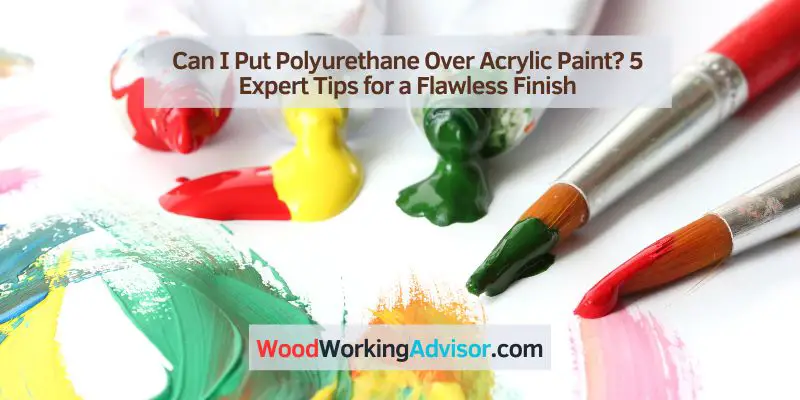Yes, you can put polyurethane over acrylic paint to provide a protective finish and enhance durability. Adding a layer of polyurethane can help protect the acrylic paint from scratches, moisture, and UV damage, giving your painted surface a longer lifespan.
By applying a clear coat of polyurethane, you can achieve a glossy or matte finish depending on your preference. However, it is important to ensure that the acrylic paint is fully dry before applying the polyurethane to avoid any smudging or blending of colors.
Additionally, make sure to clean the surface thoroughly and sand it lightly for better adhesion of the polyurethane.
Can I Put Polyurethane Over Acrylic Paint?
Many DIY enthusiasts and artists find themselves wondering if it is possible to apply polyurethane over acrylic paint. The answer to this question can be found by understanding the properties of both polyurethane and acrylic paint, as well as their compatibility with each other. This article will provide you with all the information you need to know about using polyurethane as a protective coating for your acrylic painted surfaces.
What Is Polyurethane?
Polyurethane is a versatile and durable finish that is commonly used to protect and enhance a variety of surfaces, including wood, metal, and plastic. It is known for its excellent resistance to scratches, water, and chemicals, making it an ideal choice for protecting painted surfaces from everyday wear and tear.

Compatibility Of Polyurethane With Acrylic Paint
When it comes to the compatibility of polyurethane with acrylic paint, it is important to note that these two substances can work together harmoniously. Acrylic paint is a water-based paint that dries quickly and forms a hard, protective film. On the other hand, polyurethane is typically oil-based and offers a strong and durable protective layer.
Before applying polyurethane over acrylic paint, there are a few considerations to keep in mind:
- Make sure the acrylic paint has fully cured. It is recommended to wait at least 24 hours before applying polyurethane to ensure proper adhesion.
- Clean the surface thoroughly to remove any dust, dirt, or oils that may interfere with the adhesion of the polyurethane.
- Apply the polyurethane in thin, even coats, allowing each coat to dry completely before applying the next. This will help prevent bubbling, streaking, or uneven finish.
- Consider using a water-based polyurethane if you are concerned about odor or prefer easier cleanup.
By following these guidelines, you can safely and effectively apply polyurethane over acrylic paint, adding an extra layer of protection and enhancing the longevity of your painted surfaces.
In conclusion, polyurethane can be applied over acrylic paint to provide a durable and protective finish. Understanding the properties and compatibility of both polyurethane and acrylic paint is essential for achieving a successful outcome. Remember to properly prepare the surface and apply the polyurethane in thin, even coats for the best results.
5 Expert Tips For A Flawless Finish
When it comes to protecting and enhancing your acrylic paint project, applying a layer of polyurethane is a popular and effective option. However, if you want to achieve a flawless finish, there are a few expert tips you should keep in mind. From proper preparation to choosing the right polyurethane, here are five tips that will help you achieve the perfect result:
Preparation Is Key
Before applying polyurethane over your acrylic paint, proper preparation is essential. Start by ensuring your painting surface is clean and free of any dust, dirt, or grease. You can use a gentle cleaner or mild detergent to remove any contaminants. Additionally, sand the surface lightly to create a smooth and even texture for the polyurethane to adhere to. Remember to wipe away any sanding dust before proceeding with the application.
Choosing The Right Polyurethane
The type of polyurethane you use can make a significant difference in the final outcome. For acrylic paint, it is recommended to choose a water-based polyurethane as it is less likely to yellow over time. Look for a high-quality product that offers durability and UV protection to ensure your artwork remains vibrant and protected for years to come. Opt for a clear, non-yellowing formula to preserve the true colors of your acrylic paint.
Application Techniques
Proper application techniques play a crucial role in achieving a flawless finish. To start, use a high-quality brush or a foam applicator to apply the polyurethane evenly. Work in thin, smooth and even strokes, following the natural grain of the surface. Avoid excessive brushing or overworking the polyurethane, as this can lead to streaks or bubbles. If you prefer a smoother finish, lightly sand the surface between coats, ensuring to remove any sanding dust before proceeding.
Curing And Drying Time
Once you have applied the polyurethane, ensure adequate curing and drying time for the best results. Polyurethane requires time to fully cure and harden, so be patient and avoid touching or exposing your project to moisture during this process. Follow the manufacturer’s instructions regarding the recommended drying and curing time, as these may vary depending on the specific product and environmental conditions.

Maintenance And Longevity
To maintain the longevity of your polyurethane finish, regular maintenance is essential. Avoid using harsh chemicals or abrasive cleaners that can damage the protective layer. Instead, use a mild soap and water solution or a gentle acrylic cleaner to clean the surface. Depending on the wear and tear, you may want to periodically apply another coat of polyurethane to refresh the protection and enhance the appearance.
In conclusion, by following these expert tips for a flawless finish, you can confidently apply polyurethane over your acrylic paint projects. Proper preparation, choosing the right product, applying with the correct technique, allowing for adequate curing and drying time, as well as regular maintenance, will ensure your artwork remains protected and showcases its true beauty.
Frequently Asked Questions On Can I Put Polyurethane Over Acrylic Paint
Can I Put Polyurethane Over Acrylic Paint?
Yes, you can apply polyurethane over acrylic paint. It provides a protective layer and enhances the durability of the paint. It is advisable to properly clean and prepare the surface before applying polyurethane to ensure proper adhesion. Make sure the paint is completely dry before applying the polyurethane.
Conclusion
To summarize, applying polyurethane over acrylic paint can provide a durable and protective finish to your artwork or project. It enhances the paint’s longevity and adds a glossy or satin sheen. However, it’s important to remember that proper preparation and application techniques are crucial for a successful outcome.
Follow the guidelines outlined to achieve the best results. Start experimenting with polyurethane over acrylic paint and take your creative endeavors to the next level.



3 thoughts on “Can I Put Polyurethane Over Acrylic Paint? 5 Expert Tips for a Flawless Finish”